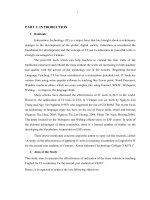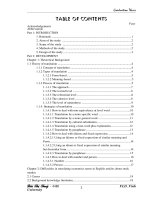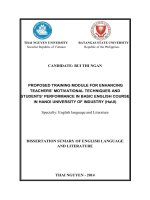Study on tardiness of students in hanoi university
Bạn đang xem bản rút gọn của tài liệu. Xem và tải ngay bản đầy đủ của tài liệu tại đây (260.66 KB, 22 trang )
Statistics presentation
Study on Tardiness of students in Hanoi University
GROUP 1
Tut1_BA
OUTLINE
I. Research methodology
II. Descriptive results and findings
III. Hypothesis testing
IV. Evaluation
I. Research methodology
1. Population and sample
2. Questionarie design
3. Sample size
4. Sampling method
5. Data collection
1. Population and sample
•
•
Population: Hanoi university’s students
Sample: 100 students
2.Questionaire design
Total: 7 questions about tardiness opinion
2 questions: - What they think about the habits of going to class late.
- how often they come to university late
2 questions: - Reason
- Results from this habit
1 question: Experience that students gain from the results
2 questions: - Whether they change habit
- Method
3. Sample size
•
100 students
4. Sampling method
•
Deliver questionnaire to 100 students & selected exactly 100 students
5. Data collection
•
Collecting data: - face to face communication
- Google form
•
•
•
Organizing and presenting: Chart and graphs
Hypothesis testing
Discussion and analysis.
II. Descriptive results and findings
•
•
•
Questionnaire : 11 questions
4 questions : personal information (name, email, gender & school year)
7 questions : opinion about tardiness
Q1. What is your opinion on tardiness?
nearly 1/3 of the HANU students are aware of the importance of the
time they come to class for their study.
Q2. How often do you come to university late a week?
82 students being late equal or more than 1 day
a week
=> change behavior
Q3. What is the main reasons which make you come to class late?
The majority of them are interrupted by traffic jam ( 55
students) and the difficulty in waking up early ( 48
students)
Q4. What are the results for coming late?
63% => bad habit for students & influence on others
Q5. Do you gain experience from the results of
coming late?
Q6. Will you change your late habits?
Q7. How will you change your late habits?
III. HYPOTHESIS TESTING
1. Research question
•. Design 7Qs should change tardiness habits of HANU students or not
2. Assumption
•. «Yes» and «No» answers qualitative data
•. Binominal distribution
•. Parameter of interest: (p)
•. More than 70% students coming late to school with equal or greater than 1 day
•. should change their habit
3. Data analysis
•
Sample size: n =100
(np=100x0.7=70>5; n(1-p)=100x0.3=30>5)
•
Z-test (upper tail test)
•
H0 : p<=0.7
Ha : p> 0.7
•
Significant level: α = 0.05
•
Critical value is Z0.05≈ 1.645. Reject H0 if Z>1.645
4.
Hypothesis testing procedure
•
Step 1: The null and alternative hypotheses
H0: p≤ 0.7
Ha: p> 0.7
•
Step 2: Test statistic
z=
•
(with q=1-p=0.3, p^=82/100=0.82)
Step 3: Significant level
α = 0.05
•
Step 4: Decision rule
Reject H0 if Z >1.645
•
•
Step 5: Value of test statistic
Step 6: Conclusion
Z = 2.62 > 1.645 , we reject H0.
P-value
•
With z = 2.62, we have:
p-value = P (Z > 2.62) = 1 -0.9956 = 0.0044
there is enough evidence at the level of significance α = 0.05
Ha is true
there is enough evidence to conclude that more than 70% of Hanu students should change their late-for-class
habits
IV. Evaluation
1. Limitation
2. Implication
3. Recommendation
4. Conclusion
1. Limitation
-
Poor self awareness on the matter
Dishonesty in answering survey
2. Implication
-
Consequential realization
Willingness to change
3. Recommendation
- Stop using electronics before going to bed => sleep early
-
Reschedule timetable to avoid coincident; go to school a few minutes early
Motivate yourself
4. Conclusion
-
Determine situation: current rate and awareness
Significance of punctuality
Apply recommendation => Improve









